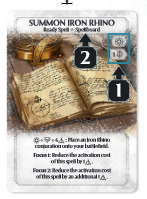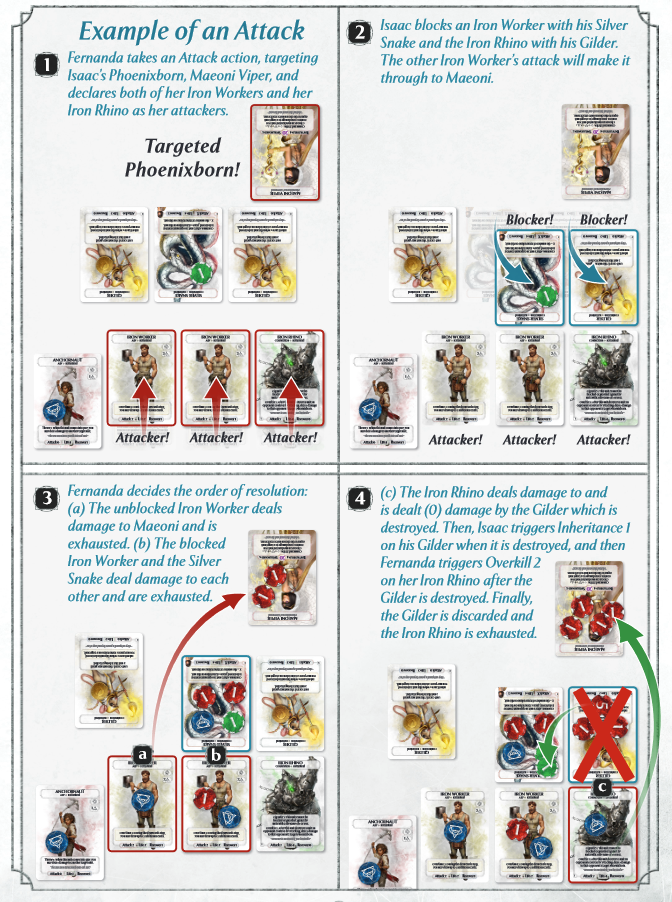Main Action
Pay a Cost
To take this main action, play or activate a card where the symbol appears in the play or activation cost.
Playing a Card
Many turns in Ashes consist of playing a card or activating a card that was played on a previous turn. It is common for your entire turn to consist of playing or activating just one or two cards. To play a card from your hand, first pay its cost [1] , then place it as directed by the card’s placement [2].
Paying Costs
There are 5 different types of costs:
Main Action: Take your main action for the turn.
Side Action: Take your side action for the turn.
Exhaust: Place 1 exhaustion token on this card.
Discard: Discard a number of cards from your hand equal to the number shown.
Magic: Exhaust dice of the appropriate type and number by moving them from your active pool to your exhausted pool. That number is known as the magic play cost. Remember that higher level dice can be used to pay for lower level costs.
Example: Paying Costs
Example: Paying Costs
 To play Summon Iron Rhino to your spellboard, take your main action for the turn and exhaust 1 or die.
To play Summon Iron Rhino to your spellboard, take your main action for the turn and exhaust 1 or die.
 To activate its effect, take your main action, place 1 exhaustion token on the card, and exhaust any six dice (any die can be used as ).
To activate its effect, take your main action, place 1 exhaustion token on the card, and exhaust any six dice (any die can be used as ).
Parallel Costs
Some cards have two or more connected costs in their play cost or their activation cost. These costs are called parallel costs. To pay a parallel cost, pay one of the options, plus any other costs.
Attack
When you Attack, 1 or more of your unexhausted units will enter battle.
Unexhausted: A card with no exhaustiontokens on it.
Battle: In battle an attacker deals damage equal to its attack value to a defender. Sometimes the defender will counter. After the battle, 1 exhaustion token is placed on the attacker, and 1 on the defender, if it countered.
Counter: When a defender counters, it deals damage equal to its attack value back to its attacker. Attack and counter damage occur simultaneously.
To take an Attack action, first target an opponent’s PHOENIXBORN or UNIT.
If you target a PHOENIXBORN do the following in order:
- Declare Attackers: Choose ANY NUMBER of unexhausted units you control to be attackers.
- Opponent Declares Blockers: Your opponent may block each attacker with up to one unexhausted unit they control.
- Resolve Battles: One at a time, resolve each battle in an order of your choice.
- If Blocked: The attacker battles its blocker and the blocker counters.
- If Unblocked: The attacker battles the target Phoenixborn.
Note: Resolution order matters! If a blocker is destroyed before it battles, the attacker it was blocking becomes unblocked.
If you target a UNIT do the following in order:
- Declare Attackers: Choose ONE unexhausted unit you control to be the attacker.
- Opponent Declares Guard: Your opponent may guard with their Phoenixborn or with an unexhausted unit they control with the Unit Guard ability. Note: A Phoenixborn can only guard once per round, but may guard even if it is exhausted.
- Resolve Battle
- If Guarded: The attacker battles the guard and, if the guard is a unit, the guard counters. If the guard is a Phoenixborn, it is rotated 90° to indicate it is unable to guard again this round.
- If Unguarded: The attacker battles the target unit. If it is unexhausted your opponent may counter with it.
Pass
When you Pass, your main action is to do nothing. You may still take a side action. If your opponent does not Pass on their next turn, then when it is your turn again you may take any main action. If both players Pass on consecutive turns, the player turns phase ends and players move on to the recovery phase of the round.



